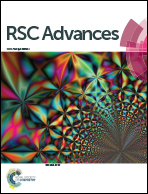Enhanced photoresponse of a high-performance self-powered UV photodetector based on ZnO nanorods and a novel electrolyte by the piezo-phototronic effect†
Abstract
A flexible self-powered ultraviolet (UV) photodetector based on ZnO nanorods (NRs) and a novel iodine-free quasi solid-state electrolyte was fabricated. The obtained device has a fast and high response to UV light illumination at zero bias and also shows long-term stability. The responsivity is 50.5 mA W−1 and the response time is less than 0.2 s. Strain-induced piezo-phototronic potential within wurtzite-structured ZnO can optimize the performance of corresponding optoelectronic devices since it could effectively tune the charge carriers' separation and transport. The photoresponse performances of the photodetector under different upward angles (tensile strain) and downward angles (compressive strain) at 0 V bias were studied in detail. A 163% change of responsivity was obtained when the downward angle reached 60°. The enhancement could be interpreted by the piezo-phototronic effect. The piezoelectric potential (piezopotential) at the ZnO NRs/electrolyte interface can expand the built-in field, and as a result, it is easier for charge carriers to separate and transport.



 Please wait while we load your content...
Please wait while we load your content...